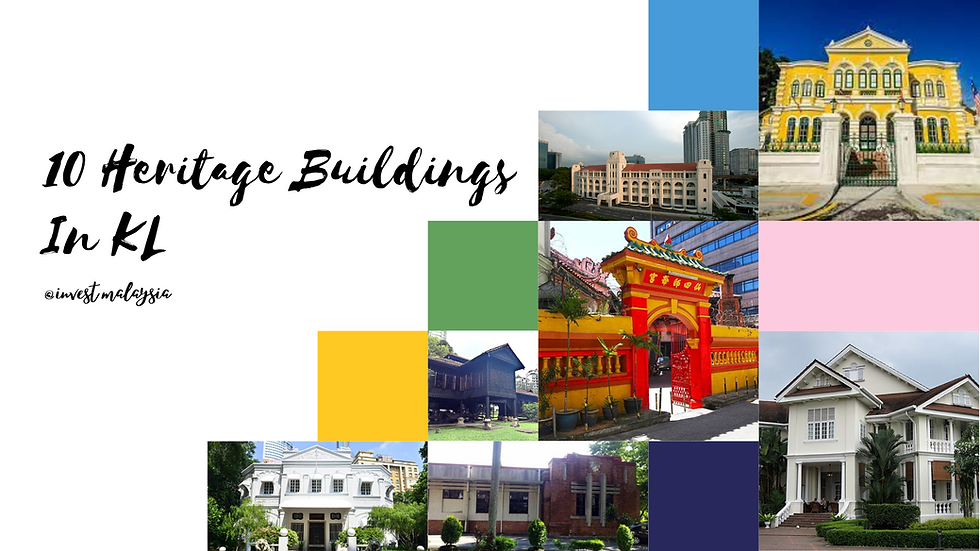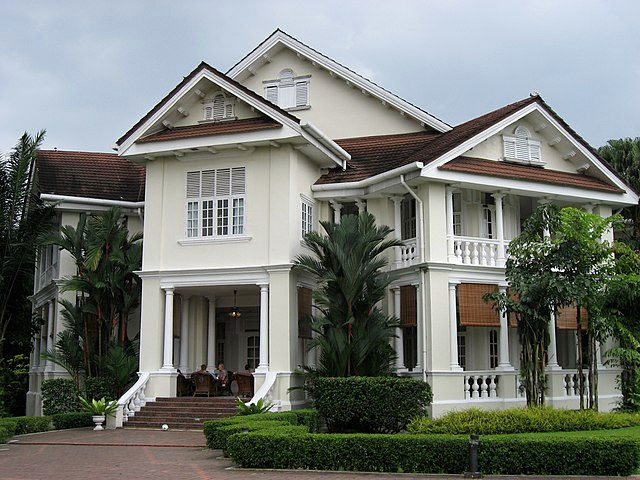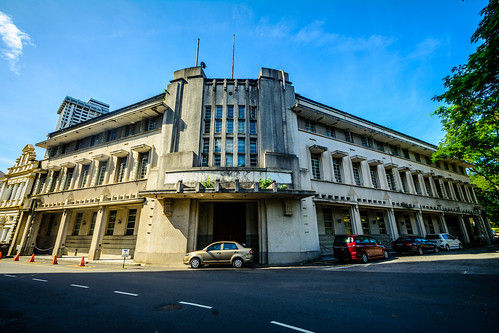
KL street’s comprise a lot of buildings ranging from heritage ones to amazing skyscrapers that shows just how much Malaysia’s capital city has changed and developed over the years.
Besides the well-known colonial architectural marvels of KL, here are 10 heritage buildings in KL that you should know.

1. Loke Mansion – white mansion KL
Loke Mansion, privately owned by Loke Yew previously, a tin tycoon who was once the richest man in Malaysia, the mansion is an opulent whitewashed mansion in the heart of KL that was the last and final residence.
The mansion was built in 1892 by Cheow Ah Yeok, a Chinese merchant acquainted with Loke Yew and China Kapitan Yap Ah Loy. It has been around for a whopping 129 years and it took over 12 years to complete. It is one of the first residences in the Federated States of Malaya to have running electricity.
Over the course of the century, the mansion was occupied by several entities after the death of Loke Yew in 1917. Then, the building was occupied by Japanese soldiers during World War II, used by Sam Min Chu Yi Youth Corps as a school, and converted into a police training centre during the 1948 Communist Emergency.
It was left abandoned from 1958 to 197, but brought back to life as an art gallery, Samad Art Gallery and Artiquarium, and Lim Kok Wing art school up till 2000 when it was unoccupied once again. Since 2014, the mansion has been leased by Cheang & Ariff law firm and undergone several refurbishments.
The mansion remains standing today. And here’s the address of the building:
Address: No. 273A, Jalan Medan Tuanku, 50300 Kuala Lumpur, WP Kuala Lumpur.

2. Bangunan Sulaiman
KL Railway Station and the Malayan Railway Administration Building are colonial buildings that make up KL’s collection of architectural marvels.
A lesser-known heritage building, once part of the Federated Malay States Railway alongside these two icons, is Bangunan Sulaiman, it was built in 1926 and completed in 1930, around 40 years after KL Railway Station was opened to the public.
The building has since been recognised as a National Heritage in 2018, and is now where Asian International Arbitration Centre (AIAC) is located.
Address: Jalan Sultan Hishamuddin, Kampung Attap, 50000 Kuala Lumpur, WP Kuala Lumpur

3. Rubber Research Institute
Rubber Research Institute of Malaysia is a red-brick building, made up of three single-storey, symmetrical buildings connected by corridors and was designed by British architect Arthur Oakley Coltman. It was declared a National Heritage site in November 2009, and built years before in 1937.
Inside the building, valuable research and development of rubber takes place. A wall of five bas-relief panels carved by Italian sculptor Rudolfo Nolli can be found in the building, telling the story of Malaysia’s major export – from planting rubber trees to rubber usage in our daily lives.
Address: 260, Jalan Ampang, Kampung Datok Keramat, 55000 Kuala Lumpur, WP Kuala Lumpur

4. Oriental Building
An eye-catching landmark on Jalan Tun Perak, Oriental Building. But when the building was first unveiled to the public in 1931, it was deemed a lively and modern addition to KL’s commercial centre during the Great Depression, with its ground floor even designed to house retail shops.
During the 1930s, it was 82ft tall, considered also one of the tallest building in KL. Nonetheless, it remains one of the largest art deco buildings in KL, next to Central Market.
Just five years after it opened, the building was affected by earthquake tremors felt in our country on 19th September 1936. Fortunately, there were only minor damages to its upper floors. The Oriental Government Security Life Assurance Co. was inhabiting the space then. The building was later home to Radio Malaya, with a signage of its name added below ‘Oriental Building’ to reflect this, and subsequently, the location of the High Commissioner of India and Life Insurance Corporation of India.
Address: Jalan Tun Perak, City Centre, 50050 Kuala Lumpur, WP Kuala Lumpur

5. Rumah Penghulu Abu Seman
Bukit Bintang is known as a shopping district home to popular malls such as Lot 10 and Pavilion KL. WIth an 8-minute walk from here is Rumah Penghulu Abu Seman, one of the oldest surviving traditional Malay houses in Malaysia that’s built on stilts and constructed from wood.
It was owned by a wealthy village head in 1916, the house was originally located in Bandar Baharu, Kedah. With the efforts to rescue, relocate and restore the house in downtown KL – over a 4-hour drive away – was carried out by Badan Warisan Malaysia, a non-government organisation that seeks to preserve Malaysia’s heritage.
Today, KL-rian can see how Malays once lived outside of the cities way back by visiting the house for free at Badan Warisan Malaysia on Jalan Stonor.
Address: 2, Jalan Stonor, 50450 Kuala Lumpur, WP Kuala Lumpur

6. Carcosa Seri Negara
Carcosa Seri Negara, it was featured in the 2018 US film Crazy Rich Asians as the residence of one of its lead characters.
Carcosa Seri Negara comprises two mansions – Carcosa and Seri Negara. Carcosa, the first mansion, was built in 1896 as the residence of the first British High Commissioner, Sir Frank Swettenham. While Seri Negara, a smaller house also known as the King’s House, was added to the grounds in 1913 as a guest house.
During Malaysia’s independence movement, the mansion was used as a meeting place and where Malaysia’s Constitution was drafted. The Federation of Malaya agreement was signed here too in 1957.
It was briefly the residence of visiting dignitaries, hosting prominent individuals such as Queen Elizabeth and the late Prince Phillip of England, who stayed here during their visit to Malaysia for the 1989 Commonwealth Heads of Government Meeting.
The mansion was transferred to the care of the Asian Heritage Museum (AMH) on a 3-year lease in 2017, with visitors able to tour the historic mansion’s grounds. Now, the mansion is currently under the possession of the Government of Malaysia and not open to the public.
Address: Jalan Kebun Bunga, Tasik Perdana, 55100 Kuala Lumpur, WP Kuala Lumpur

7. Sin Sze Si Ya Temple
Temple in KL that’s been around for more than 150 years is Sin Sze Si Ya Temple, considered the oldest Taoist temple in the city.
The temple was founded by Kapitan Yap Ah Loy in 1864 to honour patron deities by Sin Sze Si Ya. Today, Sin Sze Si Ya Temple remains an important site for religious devotees as it once was to Chinese migrants during the 19th century.
Address: 113A, Jalan Tun H S Lee, City Centre, 50050 Kuala Lumpur, WP Kuala Lumpur

8. Chow Kit Mansion
Chow Kit Mansion, another ornate mansion in KL, which was the residence of Loke Chow Kit, a prominent figure in KL who opened the first department store in the city.
In 1909, Chow Kit and his family left the residence, then it was converted into Empire Hotel, becoming one of two luxe hotels in KL during the 1900s. The hotel was later rebranded as Peninsular Hotel, but fell out of popularity due to the competition of other major hotels in the city.
The building was used as the headquarters of the 2nd Guards Brigade, after World War II. It was scheduled to be demolished and replaced with a luxury apartment building. Before the city could lose an architectural marvel, Chow Kit Mansion was transferred to the custody of DBKL, with restoration works carried out by an architect group to restore the house to its former glory.
Now, the mansion is known as Rumah Tangsi, a buzzing event space that hosts art exhibitions, wedding photoshoots, local bazaars and more.
Address: 10, Jalan Tangsi, Tasik Perdana, 50480 Kuala Lumpur, WP Kuala Lumpur

9. Anglo-Oriental Building
Anglo-Oriental Building built in 1937 over 90 years ago, was designed by Arthur Oakley Coltman. It sits on the corner of Jalan Tangsi and Jalan Parliamen.
Anglo-Oriental Building was once hailed as a modern building in its time, with a “special motor car garage”, or parking lots, built into its ground floor. After that, Anglo-Oriental Malaya Ltd, a subsidiary of Anglo-Oriental Mining Corporation, operated from here, which lends to the building’s name. Fast forward to 1941, and the building was briefly home to Mahkota College, when it underwent several renovations.
Now, the building is commonly known as Wisma Ekran, after Ekran Berhad acquired it.
Address: Jalan Tangsi, Perdana Botanical Gardens, 50480 Kuala Lumpur

10. Vivekananda Ashrama
Vivekananda Ashrama was built in 1904 by Jaffna Tamil immigrants, with a bronze statue erected in front of the building to honour Swami Vivekanada – an Indian Hindu monk who is considered a patriotic saint in India.
The ashram was an important site for Sri Lankan Jaffna in Brickfields, KL, as their first settlement was said to have relocated here. The building served as a reading room by the Tamil community in Brickfields in its early days, where followers of Vivekanada would congregate to study his works.
It branched out into Vivekananda Tamil School Brickfields in 1914, which is just a 3-minute walk from the ashram, to educate children. Malaysia’s first prime minister, Tunku Abdul Rahman, officiated the school’s opening on 13th September 1958.
Several public contributions and efforts have helped conserve the prominent building and statue in KL, as there were attempts by trustees to sell the land upon which it stands so it could be turned into a 23-storey luxury apartment in recent years.
The over 100-year-old building has since been gazetted as a National Heritage site in 2016.
Address: No. 220, Jalan Tun Sambanthan, Brickfields, 50470 Kuala Lumpur, WP Kuala Lumpur
These heritage buildings with lesser-known histories in KL that are part of the city’s infrastructure all the same serves as a reminder of our country’s development and history.
Comments